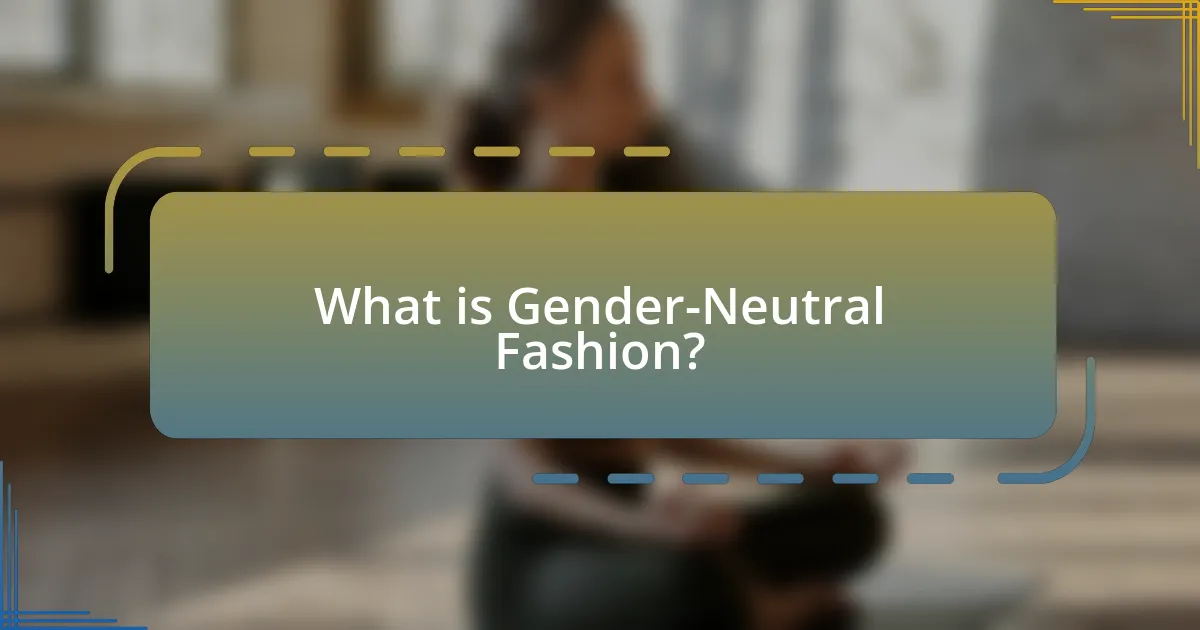The article “The Evolution of Gender-Neutral Fashion: A Style Guide” explores the concept of gender-neutral fashion, which encompasses clothing designed for individuals regardless of gender identity, promoting inclusivity and challenging traditional gender norms. It traces the historical evolution of this fashion movement from the early 20th century to the present, highlighting key influences such as feminist movements and the LGBTQ+ rights movement. The article discusses the characteristics of gender-neutral fashion, notable brands and designers leading the way, and practical tips for incorporating gender-neutral pieces into personal wardrobes, emphasizing the importance of comfort, versatility, and personal expression in contemporary fashion.

What is Gender-Neutral Fashion?
Gender-neutral fashion refers to clothing that is designed to be worn by individuals regardless of their gender identity, promoting inclusivity and breaking traditional gender norms. This fashion movement emerged as a response to the rigid binary classifications of male and female clothing, allowing for a more fluid expression of personal style. The rise of gender-neutral fashion is supported by cultural shifts towards acceptance of diverse gender identities, with brands increasingly offering unisex collections that prioritize comfort and versatility over conventional gendered designs.
How has the concept of gender-neutral fashion evolved over time?
The concept of gender-neutral fashion has evolved significantly from the early 20th century to the present day, transitioning from strictly defined gender roles in clothing to a more inclusive approach. Initially, fashion was heavily gendered, with distinct styles for men and women, but the 1960s and 1970s saw the rise of unisex clothing, influenced by social movements advocating for gender equality and personal expression. In the 1990s, designers like Jean-Paul Gaultier and brands such as Comme des Garçons began to challenge traditional gender norms, introducing collections that blurred the lines between masculine and feminine aesthetics.
In recent years, the growth of the LGBTQ+ rights movement and a broader societal acceptance of diverse gender identities have further propelled the popularity of gender-neutral fashion. Brands like Telfar and Phlemuns have gained recognition for their gender-inclusive designs, reflecting a shift towards a more fluid understanding of gender in fashion. This evolution is evidenced by the increasing number of fashion shows featuring gender-neutral collections and the rise of retailers offering unisex lines, indicating a significant cultural shift towards inclusivity in the fashion industry.
What historical events influenced the rise of gender-neutral fashion?
The rise of gender-neutral fashion has been influenced by several historical events, notably the feminist movements of the 1960s and 1970s, which challenged traditional gender roles and norms. These movements advocated for equality and freedom of expression, leading to a shift in societal perceptions of gender and clothing. Additionally, the androgynous styles popularized by musicians and cultural icons, such as David Bowie and Prince, during the same era further blurred the lines between masculine and feminine attire. The LGBTQ+ rights movement, particularly the Stonewall riots in 1969, also played a crucial role in promoting acceptance of diverse gender identities and expressions, paving the way for fashion that transcends traditional gender boundaries. These events collectively contributed to the emergence of gender-neutral fashion as a reflection of evolving societal attitudes towards gender and identity.
How have societal attitudes towards gender and fashion changed?
Societal attitudes towards gender and fashion have shifted significantly towards inclusivity and fluidity. Historically, fashion was strictly divided along gender lines, with distinct styles for men and women; however, recent decades have seen a growing acceptance of gender-neutral and unisex clothing. This change is evidenced by the rise of brands like Telfar and the increasing visibility of gender-nonconforming individuals in mainstream media, which challenge traditional norms. Additionally, surveys indicate that younger generations prioritize self-expression over conformity to gendered fashion, with 70% of Gen Z expressing a desire for more inclusive clothing options. This evolution reflects broader cultural movements advocating for gender equality and diversity, reshaping how society perceives and engages with fashion.
Why is gender-neutral fashion important in today’s society?
Gender-neutral fashion is important in today’s society because it promotes inclusivity and challenges traditional gender norms. This shift allows individuals to express their identity without the constraints of binary classifications, fostering a sense of belonging for diverse gender identities. Research indicates that 62% of Gen Z consumers prefer brands that offer gender-neutral options, reflecting a growing demand for such fashion. By embracing gender-neutral styles, the fashion industry not only caters to a wider audience but also contributes to social progress by normalizing fluidity in gender expression.
What role does gender-neutral fashion play in promoting inclusivity?
Gender-neutral fashion plays a crucial role in promoting inclusivity by challenging traditional gender norms and allowing individuals to express their identity without the constraints of binary classifications. This fashion movement encourages a broader acceptance of diverse gender identities, as it provides clothing options that are not limited to male or female categories. For instance, brands like Telfar and Rad Hourani have successfully created collections that cater to all genders, demonstrating that clothing can be designed for comfort and style rather than adhering to societal expectations. By fostering an environment where everyone can find clothing that resonates with their personal identity, gender-neutral fashion contributes to a more inclusive society, as evidenced by the increasing visibility and acceptance of non-binary and gender-fluid individuals in mainstream culture.
How does gender-neutral fashion challenge traditional gender norms?
Gender-neutral fashion challenges traditional gender norms by promoting clothing that is not restricted by societal expectations of masculinity or femininity. This movement encourages individuals to express their identity through style without conforming to binary classifications, thereby dismantling stereotypes associated with gendered clothing. For instance, brands like Telfar and Rad Hourani have successfully created collections that appeal to all genders, reflecting a shift in consumer demand for inclusivity. Research indicates that 62% of Gen Z consumers prefer brands that offer gender-neutral options, highlighting a significant cultural shift towards acceptance and diversity in fashion.

What are the Key Characteristics of Gender-Neutral Fashion?
Key characteristics of gender-neutral fashion include inclusivity, versatility, and a focus on comfort. Inclusivity is evident in designs that cater to all body types and gender identities, allowing individuals to express themselves without conforming to traditional gender norms. Versatility is showcased through clothing that can be styled in multiple ways, appealing to a broad audience regardless of gender. Comfort is prioritized in the use of soft fabrics and relaxed fits, making the clothing accessible and practical for everyday wear. These characteristics reflect a shift towards a more open-minded approach to fashion, aligning with contemporary societal values of equality and self-expression.
How do clothing designs reflect gender neutrality?
Clothing designs reflect gender neutrality by incorporating styles, cuts, and colors that are not traditionally associated with a specific gender. This approach allows for a more inclusive fashion landscape where garments can be worn by anyone, regardless of gender identity. For instance, unisex clothing lines often feature relaxed silhouettes, neutral color palettes, and versatile designs that appeal to a broad audience. The rise of brands like Telfar and the popularity of gender-neutral collections from major retailers demonstrate a shift in consumer demand for clothing that transcends binary gender norms. This evolution is supported by cultural movements advocating for gender inclusivity, which have influenced designers to create pieces that prioritize comfort and personal expression over traditional gendered aesthetics.
What types of fabrics and colors are commonly used in gender-neutral fashion?
Gender-neutral fashion commonly utilizes fabrics such as cotton, linen, denim, and jersey, which offer versatility and comfort. These materials are favored for their ability to suit various body types and styles, making them ideal for unisex designs. In terms of colors, gender-neutral fashion often features a palette that includes earth tones, pastels, and neutral shades like black, white, gray, and beige. This color selection promotes inclusivity and allows for easy mixing and matching, appealing to a broad audience. The use of these fabrics and colors reflects a shift towards more inclusive fashion choices that prioritize comfort and personal expression over traditional gender norms.
How do silhouettes and fits differ in gender-neutral clothing?
Silhouettes and fits in gender-neutral clothing typically emphasize a more relaxed and inclusive design compared to traditional gender-specific clothing. Gender-neutral clothing often features looser silhouettes that prioritize comfort and versatility, allowing for a broader range of body types to wear the same garment. For example, oversized shirts and wide-leg pants are common in gender-neutral fashion, contrasting with the tailored fits often found in men’s and women’s clothing. This approach is supported by the growing trend towards inclusivity in fashion, where brands like Telfar and Rad Hourani have successfully created collections that focus on unisex designs, demonstrating that silhouettes and fits can transcend traditional gender norms.
What are some notable brands and designers in gender-neutral fashion?
Notable brands and designers in gender-neutral fashion include Telfar, known for its inclusive designs and unisex bags; Rad Hourani, who pioneered unisex clothing with a focus on minimalist aesthetics; and Acne Studios, which offers a range of gender-neutral pieces. Additionally, brands like Ader Error and Maison Margiela have made significant contributions to the gender-neutral fashion landscape, emphasizing fluidity and breaking traditional gender norms in their collections. These brands have gained recognition for their innovative approaches and commitment to inclusivity in fashion.
Which brands are leading the way in gender-neutral clothing lines?
Brands leading the way in gender-neutral clothing lines include Telfar, Wildfang, and ASOS. Telfar is known for its inclusive designs that challenge traditional gender norms, while Wildfang focuses on providing styles that cater to all genders, emphasizing comfort and individuality. ASOS has a dedicated gender-neutral section, offering a wide range of clothing that appeals to diverse identities. These brands exemplify the shift towards inclusivity in fashion, reflecting a growing demand for gender-neutral options in the industry.
How do these brands market their gender-neutral collections?
Brands market their gender-neutral collections by emphasizing inclusivity and diversity in their advertising campaigns. They utilize social media platforms to reach a broader audience, showcasing models of various gender identities and body types to reflect a more inclusive representation. For instance, brands like Telfar and Wildfang have successfully engaged consumers by promoting their collections through collaborations with LGBTQ+ influencers and community events, which resonate with their target demographic. Additionally, they often highlight the versatility of their clothing, appealing to consumers who value functionality and personal expression over traditional gender norms. This approach not only broadens their market reach but also aligns with the growing consumer demand for gender-neutral options in fashion.

How to Incorporate Gender-Neutral Fashion into Your Wardrobe?
To incorporate gender-neutral fashion into your wardrobe, select versatile pieces that can be styled in multiple ways, such as oversized shirts, tailored trousers, and unisex outerwear. These items allow for a fluid expression of personal style regardless of gender. Research indicates that the rise of gender-neutral fashion reflects a broader cultural shift towards inclusivity, with brands like Telfar and Rad Hourani leading the way in offering collections that cater to all genders. By prioritizing comfort and fit over traditional gender norms, individuals can create a wardrobe that is both stylish and representative of their identity.
What are some essential pieces for a gender-neutral wardrobe?
Essential pieces for a gender-neutral wardrobe include tailored trousers, oversized shirts, unisex t-shirts, denim jackets, and versatile sneakers. Tailored trousers provide a structured fit suitable for various body types, while oversized shirts offer comfort and style without conforming to traditional gender norms. Unisex t-shirts serve as a basic staple that can be paired with multiple outfits, and denim jackets add a timeless layer that complements any look. Versatile sneakers are practical footwear that works for all genders, emphasizing functionality and style. These items collectively reflect the shift towards inclusivity in fashion, catering to diverse identities and preferences.
How can layering enhance a gender-neutral outfit?
Layering enhances a gender-neutral outfit by adding depth, versatility, and texture, allowing for a more personalized expression of style. This technique enables individuals to mix and match various pieces, such as shirts, jackets, and accessories, creating looks that can be easily adapted for different occasions or moods. For instance, a simple t-shirt can be transformed with the addition of a long cardigan or an oversized jacket, which not only alters the silhouette but also contributes to a more inclusive fashion statement. The practice of layering is supported by fashion experts who emphasize its role in breaking traditional gender norms, as it allows for a fluid approach to dressing that prioritizes comfort and individuality over conventional gendered styles.
What accessories complement gender-neutral fashion?
Accessories that complement gender-neutral fashion include minimalist jewelry, unisex bags, and versatile footwear. Minimalist jewelry, such as simple rings and necklaces, enhances outfits without adhering to traditional gender norms. Unisex bags, like crossbody or tote styles, provide functionality and style for all genders. Versatile footwear, including sneakers and loafers, offers comfort and can be paired with various outfits, making them suitable for anyone. These accessories support the inclusive nature of gender-neutral fashion by prioritizing functionality and aesthetic over gender-specific designs.
What styling tips can help achieve a gender-neutral look?
To achieve a gender-neutral look, focus on incorporating versatile clothing pieces that are not traditionally associated with a specific gender. Opt for oversized silhouettes, neutral color palettes, and unisex styles such as tailored trousers, boxy shirts, and simple dresses. These choices allow for a blend of masculine and feminine elements, promoting inclusivity in fashion. Research indicates that gender-neutral fashion has gained popularity, with a 2021 report from the Global Fashion Agenda highlighting a 30% increase in brands offering unisex collections, reflecting a shift towards more inclusive styling options.
How can one mix and match pieces for versatility?
To mix and match pieces for versatility, one should focus on selecting neutral colors and timeless styles that can be easily combined. For instance, a basic white t-shirt can be paired with various bottoms, such as jeans, skirts, or shorts, allowing for multiple outfit options. Additionally, layering pieces like cardigans or jackets can enhance versatility, as they can be added or removed based on the occasion. Research indicates that a capsule wardrobe, which consists of a limited number of essential items that can be mixed and matched, promotes creativity and reduces decision fatigue in daily dressing. This approach not only maximizes outfit combinations but also aligns with sustainable fashion practices by encouraging mindful consumption.
What role do personal expression and comfort play in styling gender-neutral outfits?
Personal expression and comfort are fundamental in styling gender-neutral outfits, as they allow individuals to convey their identity while feeling at ease in their clothing choices. Gender-neutral fashion emphasizes inclusivity, enabling wearers to select pieces that resonate with their personal style without conforming to traditional gender norms. Research indicates that clothing choices significantly impact self-esteem and body image; for instance, a study published in the Journal of Fashion Marketing and Management found that individuals who dress in a way that aligns with their self-identity report higher levels of satisfaction and confidence. Therefore, personal expression and comfort not only enhance the aesthetic appeal of gender-neutral outfits but also contribute to the overall well-being of the wearer.
What are some common challenges when adopting gender-neutral fashion?
Common challenges when adopting gender-neutral fashion include societal stigma, limited availability of options, and sizing inconsistencies. Societal stigma often leads to resistance from individuals who may not understand or accept non-binary clothing choices, creating a barrier for those who wish to express their identity through fashion. Limited availability of gender-neutral options in mainstream retail can hinder accessibility, as many brands still cater primarily to traditional gender norms. Additionally, sizing inconsistencies across different brands complicate the shopping experience, making it difficult for consumers to find well-fitting garments that align with their gender identity.
How can individuals overcome societal perceptions of gendered clothing?
Individuals can overcome societal perceptions of gendered clothing by actively choosing to wear garments that defy traditional gender norms. This can be achieved through personal expression, such as selecting clothing based on comfort and style rather than societal expectations. Research indicates that visibility and representation play crucial roles; for instance, the rise of gender-neutral fashion brands has contributed to changing perceptions, as seen in the success of brands like Telfar and Rad Hourani, which promote inclusivity. Furthermore, engaging in conversations about gender identity and fashion can foster understanding and acceptance, as evidenced by studies showing that open dialogue reduces stigma and promotes diversity in clothing choices.
What strategies can help in finding the right fit and style?
To find the right fit and style in gender-neutral fashion, individuals should prioritize understanding their body shape and proportions. This involves taking accurate measurements of key areas such as shoulders, waist, and hips to identify clothing that complements their unique physique. Additionally, experimenting with various silhouettes, such as oversized or tailored pieces, can help determine personal preferences and comfort levels.
Research indicates that inclusive sizing and diverse representation in fashion can enhance the shopping experience, as seen in studies by the Fashion Institute of Technology, which highlight the importance of fit in consumer satisfaction. Engaging with brands that offer virtual fitting tools or personalized styling services can further assist in making informed choices that align with individual style and fit needs.
What are the best practices for embracing gender-neutral fashion?
The best practices for embracing gender-neutral fashion include selecting versatile clothing that transcends traditional gender norms, such as oversized silhouettes, unisex cuts, and neutral color palettes. This approach allows individuals to express their identity without being confined to gender-specific styles. Additionally, incorporating layering techniques and accessories can enhance the adaptability of outfits, making them suitable for various occasions. Research indicates that the rise of gender-neutral fashion reflects broader societal shifts towards inclusivity and self-expression, as seen in brands like Telfar and Rad Hourani, which prioritize unisex designs.














